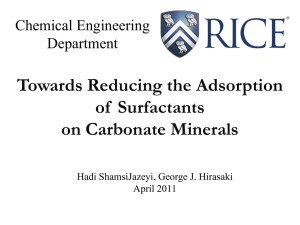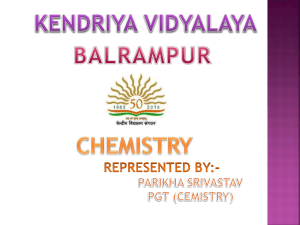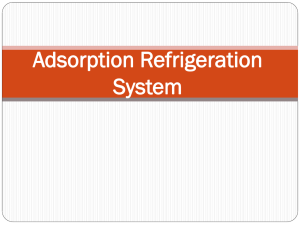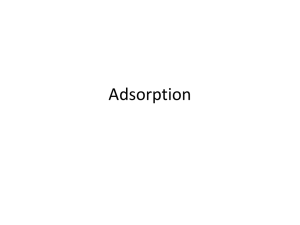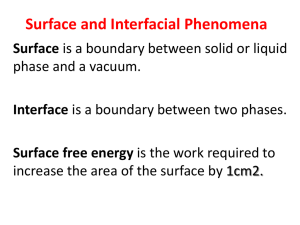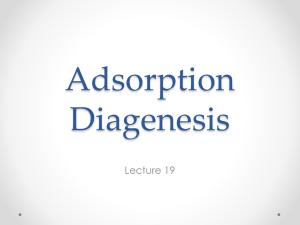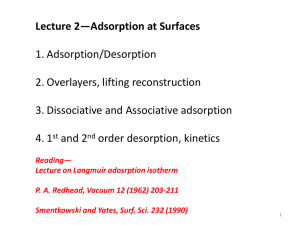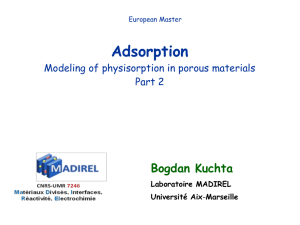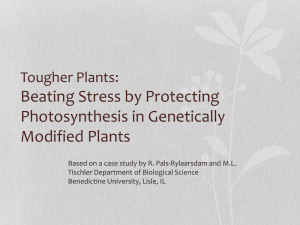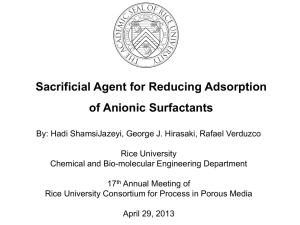05_Hadi
advertisement
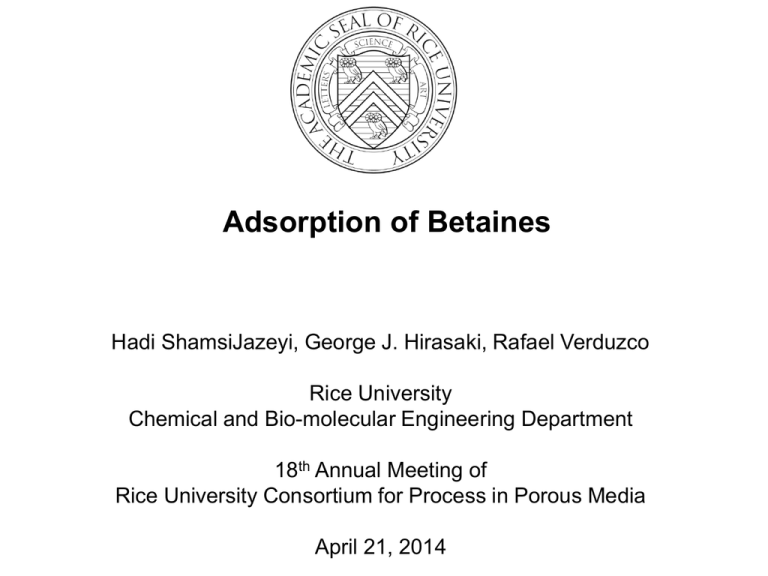
Adsorption of Betaines Hadi ShamsiJazeyi, George J. Hirasaki, Rafael Verduzco Rice University Chemical and Bio-molecular Engineering Department 18th Annual Meeting of Rice University Consortium for Process in Porous Media April 21, 2014 Outline Introduction Adsorption measurement Can polyacrylate reduce adsorption of lauryl betaine? Different chemicals as sacrificial agent for betaines Effect of pH (surface charge) on adsorption of betaines Effect of anionic surfactant on pH dependency of betaine adsorption Hypothesis: molecular mechanism of adsorption of betaines Introduction Surfactant adsorption on the rock is a major cost issue for EOR Betaine is a class of zwitterionic surfactants (with two opposite charge on each surfactant molecule) Adsorption of betaine can be very high at certain conditions Polymeric sacrificial agent (sodium polyacrylate) was tested for reducing adsorption of anionic surfactants and showed up to 80% reduction in total cost of materials We study conditions by which the adsorption of betaine is minimum Measurement of Concentration and Adsorption of Lauryl Betaine Plateau region of adsorption isotherms should be measured. Both initial and equilibrium concentrations are measured. Equilibrium concentration should be far enough from initial concentration, so that the noise in measurement can be neglected. Concentration of betaine is measured by two phase titration at pH<1 We made sure that the anionic surfactant has no effect on betaine measurement at this low pH Can Polyacrylate Reduce Adsorption of Lauryl Betaine? Adsorption on Kaolinite Room Temperature, Batch Adsorption Study Adsorption on Silica Room Temperature Batch Adsorption Study Different chemicals as sacrificial agent for betaines a) b) 6 30 25 20 15 5 Adsorption (mg/g) Adsorption (mg/g) 35 Adsorption on Kaolinite 4 3 2 10 1 5 0 0 Adsorption on Silica Effect of pH (surface charge) on adsorption of betaines Adsorption on Kaolinite Adsorption on Silica Increase in pH Adsorption Decreases then Increases and may Plateau Effect of pH on Zeta Potential and Surface Charge Equilibrium pH 2 3 4 5 6 7 8 9 10 11 12 13 Zeta Potential (mV) 20 0 -20 -40 Silica -60 Kaolinite -80 -100 -120 -140 Ionic strength = 0.1 M Room temperature Kaolinite data from: D.J.A. Williams, K.P. Williams, Electrophoresis and zeta potential of kaolinite, J. Colloid Interface Sci., 65 (1978) 79-87 -160 Increase in pH More Negative Charge on the Surface of Rock Effect of pH on the Charge of Lauryl Betaine 14 0% NaCl 2.5% NaCl 5% NaCl 10% NaCl 12 Experimental pH 10 Basic Region Titrated with NaOH 8 6 4 Acidic Region Titrated with HCl Both positive and negative charges are present 2 Negative charge of the betaine goes start to vanish 0 0 2 4 6 8 10 12 Calculated pH based on addition of NaOH or HCl 14 Increase in pH in the Basic Region Has No Significant Effect on Charge of Lauryl Betaine Summary of Experimental Evidence Adsorption of lauryl betaine decreases with increase in pH, but in a basic pH range, adsorption increases and may plateau. This basic pH range starts at pH 10 and 12 for silica and Kaolinite, respectively. It was shown that the charge of betaine does not change in the pH range that the Repulsive force on negative charge of betaine adsorption trend changes It was also shown that the surface of the rocks (silica or Kaolinite) becomes more negative with increase in pH Attractive force on Positive charge of betaine -- -- -- -- -- -- -- -- -- -- -- -- -- Adsorbent Surface Hypothetic molecular mechanism for adsorption of betaines 1 3 Increase in pH Decrease in Adsorption 5 Increase in pH Increase in Adsorption + + + -- + -- + + + -- + + + -11 Adsorbent Surface + + -- -- + -- + + + -- + -- + + 2 Adsorbent Surface + -- -- -- + -- + -- -- + + -- -- + 3 -- -- -- -- -- + -- -- -- + -- -- -4 -- -- -- -- -- -- -- -- -- -- -- -- -5 Adsorbent Surface Adsorbent Surface Adsorbent Surface Effect of anionic surfactant on pH dependency of betaine adsorption Adsorption on Kaolinite @ 0% NaCl Adsorption on Kaolinite @ 2.5% NaCl No sodium octonate used No sodium octonate sodium octonate:betaine = 1:2 (mass ratio) betaine:sodium octonate (1:1 mass ratio) Betaine:Sodium Octanate (1:1 Mass ratio) 35 Betaine Adsorption (mg/g) Betaine Adsorption (mg/g) 35 30 25 20 15 10 5 0 30 25 20 15 10 5 0 6 8 10 12 Equilibrium pH 14 6 8 10 12 Equilibrium pH 14 How Anionic Surfactant Reduces Adsorption of Betaines? Mechanism in low pH range (where positive charges exist) Competitive Adsorption Adsorption of betaine in the absence of anionic surfactant Mechanism in high pH range (where only negative charges are dominant) Betaine-anionic surfactant interactions + + + -- + -- + + + -- + + + -- -- -- -- -- -- -- -- -- -- -- -- -- -- Adsorbent Surface Adsorbent Surface + + + -- + -- + + + -- + + + -- -- -- -- -- -- -- -- -- -- -- -- -- -- Adsorbent Surface Adsorbent Surface Adsorption of betaine in the presence of anionic surfactant Conclusions Many chemicals tested to reduce adsorption of lauryl betaine, including sodium polyacrylate, but the reduction in adsorption is not as desired. The effect of pH on adsorption of lauryl betaine on silica and Kaolinite was investigated. With increase in pH, adsorption decreased and reached a minimum but then increased or reached a plateau. Although increase in pH makes the charge of the surface more negative, it does not have any effect on charge of betaine at pH>7 Bending of the betaine molecule due to increased negative surface charge is hypothesized to be responsible for a second increase in adsorption. Anionic surfactant can reduce the adsorption of betaine. This is explained by competitive adsorption and interaction between betaine and anionic surfactant. Back-Up Slides List of surfactants Trade or descriptive name Chemical structure Activity (%) Supplier Neodol-67 (N) bC16-17(CH3-CH-CH2-O)7-SO4Na 22.88 STEPAN IOS15-18 (I) R-CH(OH)-CH2-CH(SO3)-R (~75%) R-CH=CH-CH(SO3-)-R (~25%) where R+R’ = C12-15 21.29 STEPAN NI-Blend A Blend of Neodol-67-7PO-Sulfate and IOS15-18 (N:I)=4:1 -- -- MACKAM LB-35 C12-N+-COO- 27.9 Rhodia 3
